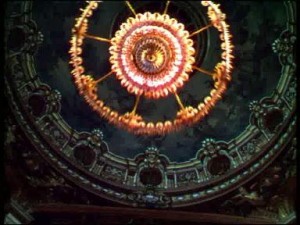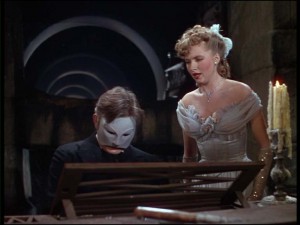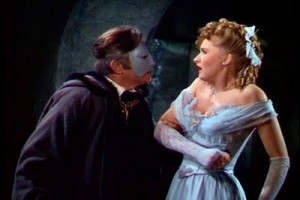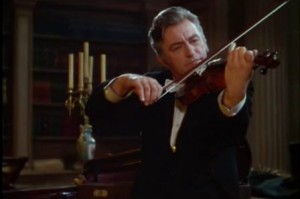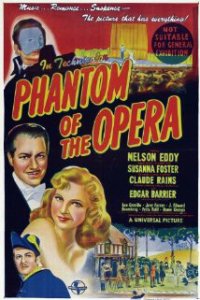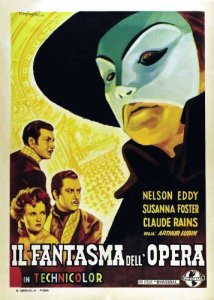Phantom of the Opera **** (1943, Nelson Eddy, Susanna Foster, Claude Rains) – Classic Movie Review 388
Universal studios light comedy specialist Arthur Lubin turns his hand to the screen’s classic of terror in 1943. And he makes a neat job of directing this incredibly beautiful, extremely opulent version of the 1925 Lon Chaney Snr silent in glorious Technicolor.
The movie’s a triumph for Claude Rains, who is stupendous as the love-struck orchestra pit violinist Enrique Claudin rushing madly around the Paris Opéra in pursuit of his true love, sweet young soprano Christine DuBois (Susanna Foster). Soon, mysterious crimes plague the opera house and there are rumours of a Phantom at work. All this madness comes after Rains avenges himself on the publisher (Miles Mander) who tries to pinch his music and gets acid chucked on his face in the process, horribly disfiguring him – hence the mask he has to wear.
Casting operetta performer Nelson Eddy as the hero Anatole Garron confirms an intriguing commitment to turning the Gaston Leroux novel Le Fantöme de l’Opera as a semi-musical, though this does, unfortunately, lower the quota of horror thrills. I suppose Eddy is the nominal hero, but actually Rains is really.
There’s no appearance by Eddy’s movie partner Jeanette Macdonald, unfortunately. This movie’s idea of Phantom as a musical can’t have been lost on Andrew Lloyd Webber, of course, as inspiration for his own show.
Edgar Barrier plays Raoul D’Aubert, the police inspector who vies with baritone Eddy and violinist Rains for Foster’s heart. When the legendary Phantom disappears with Foster in the mazes and catacombs, both of Foster’s lovers have plans to flush him out.
Somewhere in all this there’s room in there for real-life composer Franz Liszt (played by Fritz Leiber) and appearances by a lot of other character actors, most of whom sadly have precious little to do.
One question: how did the Phantom get his grand piano down into the caves below the opera house? Anyway, there are some marvellous sets down under there, and brilliant sets too of the opera house and of Rains’s Expressionist garret home, all giving the movie an enormous visual lift. Visually, it’s stunning. No wonder the colour cinematography and art direction/set decoration won Oscars.
Music: excerpts from Flotow’s ‘Martha’, two operas made up from Tchaikovsky and Mozart, and a song — ‘Lullaby of the Bells’.
The colour cinematography (Hal Mohr, W. Howard Greene) and art direction/set decoration (Alexander Golitzen, John B. Goodman, Russell A. Gausman, Ira Webb) won Oscars.
Susanna Foster scored her most famous role here as Christine Dubois in the 1943 Phantom at age 19, but after making The Climax in 1943, abruptly quit the business in 1945. She made one final film appearance in 1992’s Detour, a remake of the 1945 cult favourite. She died of heart failure on January 17 2009 at the Lillian Booth Actors Home in New Jersey, aged 84. Her rare ability to render B above high C was exploited by Universal’s musical department.
© Derek Winnert 2013 Classic Movie Review 388
Check out more reviews on http://derekwinnert.com/




